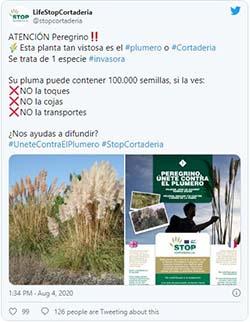
Not every LIFE project uses social media channels. But this means of communicating is extremely effective in telling your audience about your activities in a compelling way. LIFE Stop Cortaderia is using social media to help eradicate Pampas grass - one of Europe’s most harmful invasive species.
We recently spoke with Blanca Serrano, who is part of the LIFE Stop Cortaderia communication and dissemination team to find out more about the project’s successful social media strategy.
Why did you start using social media?
Everyone uses social media, especially young people. And according to our research, many of these young people don’t understand the environmental problems Pampas grass can cause. It’s therefore important to make this group aware of the problem and this is where social media comes in.
Through social media, we can share opinions, interact with citizens, and describe what we are doing and what our goals are.
How has social media helped your project?
The Pampas grass problem is well known in our region but not so much beyond. Using social media helps us raise awareness of this invasive species and what negative impact it has on the environment to an even wider audience.
We regularly post details about where Pampas grass comes from and how to get rid of it. At the same time, we want the public to find this grass and dispose of it. It’s a sort of call to action that grabs people’s attention and makes them feel part of the solution. Social media is great for that.
What social media platforms do you use?
We use Facebook, Twitter, and Instagram. We have a lot of Portuguese followers on Instagram, while in Spain, people tend to use Twitter more often. Facebook is used by both the Portuguese and the Spanish, but we also have users from the United Kingdom and France. It’s about knowing which channels work best for your audience. There’s no one size fits all solution so you should be flexible.
Who are you targeting?
We are looking to reach biodiversity experts and organisations in Spain and Portugal, especially in the Atlantic Arc area. We are also targeting transport organisations, farmers, builders, and local authorities, who are also affected by the grass. We need to cast the net wide to eradicate this invasive species.
We are also working with associations that promote the integration of people with disabilities in society. We currently employ 18 disabled people, who are carrying out highly demanding professional tasks. We want everyone to know that disabled people are more than capable of protecting the environment – just as well, if not better, than able-bodied people.
How do you decide on your social media content?
We try to post information every day. We tell our audience about what we are doing and publish interesting information about Pampas grass. We also advise on how to join our citizen science network and how best to get rid of the grass.

What kind of content do you use most?
Visual content is very important for us. So, we take a lot of photos and record videos. This results in entertaining visual content that people interact with and enjoy. We then come up with messages that complement this content. We also listen to feedback and answer questions from our audience. This is very important, and it helps us fine-tune our strategy and decide what time is the best to post and what content is most popular.
Can you give me your top tips for successful social media outreach?
- Be nice and respectful
- Provide interesting information and tips
- Listen to your audience
- Call people to action
A new app from LIFE STOP Cortaderia allows people to submit sightings of the pampas grass. This will help the team find out more about its location.
More information
The EU is also keen to limit the negative impact of invasive species. Its 2030 Biodiversity strategy aims to reduce their numbers by 50%.
Details
- Publication date
- 15 September 2020
- Author
- Executive Agency for Small and Medium-sized Enterprises

